A Multi-Objective Genetic Algorithm Approach to Sustainable Road–Stream Crossing Management
Abstract
1. Introduction
2. Materials and Methods
2.1. Study Area: The Piscataqua–Salmon Falls Watershed
2.2. Current RSC Prioritization Criteria and Schemes
2.2.1. The State Environmental Agency’s RSC Prioritization Criteria
2.2.2. The State Transportation Agency’s RSC Prioritization Criteria
2.2.3. Management Cost
2.3. NSGA-II Multi-Objective Prioritization Framework
3. Results and Discussion
3.1. NSGA-II Prioritization Model Configuration
3.2. NSGA-II vs. Conventional Prioritization Schemes
3.3. RSC Characteristics That Influence Their Selection in Optimal Solutions
4. Conclusions
Supplementary Materials
Author Contributions
Funding
Institutional Review Board Statement
Informed Consent Statement
Data Availability Statement
Acknowledgments
Conflicts of Interest
Abbreviations
| RSCs | Road–Stream Crossings |
| MOO | Multi-Objective Optimization |
| S and R | Scoring and Ranking |
| NSGA-II | Non-Dominated Sorting Genetic Algorithm |
| NH | New Hampshire |
| AOP | Aquatic Organism Passage |
| GC | Geomorphic Compatibility |
| HC | Hydraulic Capacity |
| SC | Structural Condition |
| SADES | Statewide Asset Data Exchange System |
| AADT | Annual Average Daily Traffic |
| IGD+ | Modified Inverted Generational Distance |
| CPI | Consumer Price Index |
References
- Roy, S.; Sahu, A.S. Road-Stream Crossing an in-Stream Intervention to Alter Channel Morphology of Headwater Streams: Case Study. Int. J. River Basin Manag. 2018, 16, 1–19. [Google Scholar] [CrossRef]
- Wieferich, D.J. Database of Stream Crossings in the United States. In U.S. Geological Survey; U.S. Department of the Interior: Washington, DC, USA, 2022. [Google Scholar] [CrossRef]
- Sleight, N.; Neeson, T.M. Opportunities for Collaboration between Infrastructure Agencies and Conservation Groups: Road-Stream Crossings in Oklahoma. Transp. Res. D Transp. Environ. 2018, 63, 622–631. [Google Scholar] [CrossRef]
- Southeast Aquatic Resources Partnership Comprehensive Aquatic Barrier Inventory v3.16.0 (02/14/2025). Available online: https://southeastaquatics.net/sarps-programs/aquatic-connectivity-program-act (accessed on 24 February 2025).
- Gillespie, N.; Unthank, A.; Campbell, L.; Anderson, P.; Gubernick, R.; Weinhold, M.; Cenderelli, D.; Austin, B.; McKinley, D.; Wells, S.; et al. Flood Effects on Road–Stream Crossing Infrastructure: Economic and Ecological Benefits of Stream Simulation Designs. Fisheries 2014, 39, 62–76. [Google Scholar] [CrossRef]
- Hudy, M.; Thieling, T.M.; Gillespie, N.; Smith, E.P. Distribution, Status and Perturbations to Brook Trout within the Eastern United States; Trout Unlimited: Arlington, VA, USA, 2005. [Google Scholar]
- Levine, J. An Economic Analysis of Improved Road-Stream Crossings; The Nature Conservancy Adirondack Chapter: Keene Valley, NY, USA, 2013. [Google Scholar]
- Perkin, J.S.; Gido, K.B.; Al-Ta’ani, O.; Scoglio, C. Simulating Fish Dispersal in Stream Networks Fragmented by Multiple Road Crossings. Ecol. Modell. 2013, 257, 44–56. [Google Scholar] [CrossRef]
- Rieman, B.E.; Lee, D.C.; Thurow, R.F. Distribution, Status, and Likely Future Trends of Bull Trout within the Columbia River and Klamath River Basins. N. Am. J. Fish. Manag. 1997, 17, 1111–1125. [Google Scholar] [CrossRef]
- Olson, S.A. Flood of October 8 and 9, 2005, on Cold River in Walpole, Langdon, and Alstead and on Warren Brook in Alstead, New Hampshire. In U.S. Geological Survey; U.S. Department of the Interior: Washington, DC, USA, 2006. [Google Scholar]
- Mayo, T.L.; Lin, N. Climate Change Impacts to the Coastal Flood Hazard in the Northeastern United States. Weather Clim. Extrem. 2022, 36, 100453. [Google Scholar] [CrossRef]
- Swain, D.L.; Wing, O.E.J.; Bates, P.D.; Done, J.M.; Johnson, K.A.; Cameron, D.R. Increased Flood Exposure Due to Climate Change and Population Growth in the United States. Earths Future 2020, 8, e2020EF001778. [Google Scholar] [CrossRef]
- American Society of Civil Engineers 2021 Infrastructure Report Card. Available online: https://infrastructurereportcard.org/cat-item/stormwater-infrastructure/ (accessed on 28 August 2024).
- Roy, S.G.; Daigneault, A.; Zydlewski, J.; Truhlar, A.; Smith, S.; Jain, S.; Hart, D. Coordinated River Infrastructure Decisions Improve Net Social-Ecological Benefits. Environ. Res. Lett. 2020, 15, 104054. [Google Scholar] [CrossRef]
- New England Environmental Finance Center. A Financial Impact Assessment of LD 1725: Stream Crossings. In Economics and Finance. 5; New England Environmental Finance Center: Portland, ME, USA, 2011. [Google Scholar]
- Gautam, S.; Bhattarai, R. Low-Water Crossings: An Overview of Designs Implemented along Rural, Low-Volume Roads. Environments 2018, 5, 22. [Google Scholar] [CrossRef]
- Long, J. The Economics of Culvert Replacement: Fish Passage in Eastern Maine. Available online: https://www.climatehubs.usda.gov/sites/default/files/EconomicsOfCulvertReplacement.pdf (accessed on 12 February 2025).
- Fuss & O’Neill Order of Magnitude Opinion of Construction Cost for Road-Stream Crossing Replacement. Available online: https://www.southhadley.org/DocumentCenter/View/8566/Culvert-Replacement-Cost-Estimates---May-2021?bidId= (accessed on 12 February 2025).
- New Hampshire Department of Environmental Services Funding Opportunities for Stream Crossing Projects. Available online: https://www4.des.state.nh.us/NH-Stream-Crossings/wp-content/uploads/2021/09/FundingTable_Final.pdf (accessed on 27 August 2024).
- Throwe, J.; Anderson, B.; Beary, L.; Beecher, J.; Chapman, T.; Chow, R.; Crooks, E.; Daniel, L.; Chu, E.H.; Roberts De La, M.; et al. Evaluating Stormwater Infrastructure Funding and Financing; Environmental Financial Advisory Board Stormwater Infrastructure Finance Task Force; U.S. Environmental Protection Agency: Washington, DC, USA, 2020. [Google Scholar]
- McKay, S.K.; Martin, E.H.; McIntyre, P.B.; Milt, A.W.; Moody, A.T.; Neeson, T.M. A Comparison of Approaches for Prioritizing Removal and Repair of Barriers to Stream Connectivity. River Res. Appl. 2020, 36, 1754–1761. [Google Scholar] [CrossRef]
- Stack, L.; Simpson, M.H.; Crosslin, T.; Roseen, R.; Sowers, D.; Lawson, C. The Oyster River Culvert Analysis Project; Piscataqua Region Estuaries Partnership: Durham, NH, USA, 2010. [Google Scholar]
- Hunt, J.H.; Zerges, S.M.; Roberts, B.C.; Bergendahl, B. CULVERT ASSESSMENT AND DECISION-MAKING PROCEDURES MANUAL For Federal Lands Highway; U.S. Department of Transportation Fedaral Highway Administration: Lakewood, CO, USA, 2010. [Google Scholar]
- Diebel, M.W.; Fedora, M.; Cogswell, S.; O’Hanley, J.R. Effects of Road Crossings on Habitat Connectivity for Stream-Resident Fish. River Res. Appl. 2015, 31, 1251–1261. [Google Scholar] [CrossRef]
- King, S.; O’Hanley, J.R. Optimal Fish Passage Barrier Removal—Revisited. River Res. Appl. 2016, 32, 418–428. [Google Scholar] [CrossRef]
- Konisky, R. Assessment of Road Crossings for Improving Migratory Fish Passage in the Winnicut River Watershed; The Nature Conservancy: Concord, NH, USA, 2009. [Google Scholar]
- Neeson, T.M.; Ferris, M.C.; Diebel, M.W.; Doran, P.J.; O’Hanley, J.R.; McIntyre, P.B. Enhancing Ecosystem Restoration Efficiency through Spatial and Temporal Coordination. Proc. Natl. Acad. Sci. USA 2015, 112, 6236–6241. [Google Scholar] [CrossRef]
- O’Hanley, J.R.; Wright, J.; Diebel, M.; Fedora, M.A.; Soucy, C.L. Restoring Stream Habitat Connectivity: A Proposed Method for Prioritizing the Removal of Resident Fish Passage Barriers. J. Environ. Manag. 2013, 125, 19–27. [Google Scholar] [CrossRef]
- O’Hanley, J.R.; Tomberlin, D. Optimizing the Removal of Small Fish Passage Barriers. Environ. Model. Assess. 2005, 10, 85–98. [Google Scholar] [CrossRef]
- Poplar-Jeffers, I.; Petty, T.; Anderson, J.; Kite, J.; Strager, M.; Fortney, R. Culvert Replacement and Stream Habitat Restoration: Implications from Brook Trout Management in an Appalachian Watershed, U.S.A. Restor. Ecol. 2008, 17, 404–413. [Google Scholar] [CrossRef]
- Wu, X.; Sheldon, D.; Zilberstein, S. Rounded Dynamic Programming for Tree-Structured Stochastic Network Design. In Proceedings of the AAAI Conference on Artificial Intelligence, Quebec City, QC, Canada, 20 June 2014; Volume 28. [Google Scholar]
- Bechtel, D.; Ingraham, P. River Continuity Assessment of the Ashuelot River Basin; The Nature Conservancy. Prepared for New Hampshire Department of Environmental Services, Rivers Management and Protection Program: Concord, NH, USA, 2008. [Google Scholar]
- Kurt, C.E.; McNichol, G.W. Microcomputer-Based Culvert Ranking System. Transp Res. Rec. 1335 1991, 21–27. Available online: https://trid.trb.org/view/364810 (accessed on 11 February 2025).
- Milone and MacBroom. Piscataquog River Watershed Culvert Prioritization Model; Prepared for Southern New Hampshire Planning Commission; Milone & Macbroom: Piscataquog River Watershed, NH, USA, 2016. [Google Scholar]
- Poppenwimer, C.; Kimball, K.D. Priority Connectivity Projects in the Upper Connecticut River Mitigation and Enhancement Fund (MEF) Service Area. Available online: https://www.nhcf.org/wp-content/uploads/2015/12/MEF-Priority-Connectivity-Projects-Report-2016.pdf (accessed on 11 December 2024).
- Kemp, P.S.; O’hanley, J.R. Procedures for Evaluating and Prioritising the Removal of Fish Passage Barriers: A Synthesis. Fish. Manag. Ecol. 2010, 17, 297–322. [Google Scholar] [CrossRef]
- Lin, H.; Robinson, K.F.; Walter, L. Trade-offs among Road–Stream Crossing Upgrade Prioritizations Based on Connectivity Restoration and Erosion Risk Control. River. Res. Appl. 2020, 36, 371–382. [Google Scholar] [CrossRef]
- Emmerich, M.T.M.; Deutz, A.H. A Tutorial on Multiobjective Optimization: Fundamentals and Evolutionary Methods. Nat. Comput. 2018, 17, 585–609. [Google Scholar] [CrossRef]
- Gunantara, N. A Review of Multi-Objective Optimization: Methods and Its Applications. Cogent. Eng. 2018, 5, 1502242. [Google Scholar] [CrossRef]
- Han, S.-W.; Lee, E.H.; Kim, D.-K. Multi-Objective Optimization for Skip-Stop Strategy Based on Smartcard Data Considering Total Travel Time and Equity. Transport. Res. Rec. 2021, 2675, 841–852. [Google Scholar] [CrossRef]
- Eckart, K.; McPhee, Z.; Bolisetti, T. Multiobjective Optimization of Low Impact Development Stormwater Controls. J. Hydrol. 2018, 562, 564–576. [Google Scholar] [CrossRef]
- Raseman, W.J.; Kasprzyk, J.R.; Summers, R.S.; Hohner, A.K.; Rosario-Ortiz, F.L. Multi-Objective Optimization of Water Treatment Operations for Disinfection Byproduct Control. Environ. Sci. Water Res. Technol. 2020, 6, 702–714. [Google Scholar] [CrossRef]
- Zhang, W.; Cao, K.; Liu, S.; Huang, B. A Multi-Objective Optimization Approach for Health-Care Facility Location-Allocation Problems in Highly Developed Cities Such as Hong Kong. Comput. Environ. Urban Syst. 2016, 59, 220–230. [Google Scholar] [CrossRef]
- Rajagopalan, A.; Nagarajan, K.; Bajaj, M.; Uthayakumar, S.; Prokop, L.; Blazek, V. Multi-Objective Energy Management in a Renewable and EV-Integrated Microgrid Using an Iterative Map-Based Self-Adaptive Crystal Structure Algorithm. Sci. Rep. 2024, 14, 15652. [Google Scholar] [CrossRef]
- Câmara, D. Evolution and Evolutionary Algorithms. In Bio-Inspired Networking; Elsevier: Amsterdam, The Netherlands, 2015; pp. 1–30. ISBN 978-1-78548-021-8. [Google Scholar]
- Galvan, B.; Greiner, D.; Périaux, J.; Sefrioui, M.; Winter, G. Parallel Evolutionary Computation for Solving Complex CFD Optimization Problems: A Review and Some Nozzle Applications. In Parallel Computational Fluid Dynamics 2002; Elsevier: Amsterdam, The Netherlands, 2003; pp. 573–604. ISBN 978-0-444-50680-1. [Google Scholar]
- Monteiro, A.C.B.; França, R.P.; Arthur, R.; Iano, Y. 2—The Fundamentals and Potential of Heuristics and Metaheuristics for Multiobjective Combinatorial Optimization Problems and Solution Methods. In Multi-Objective Combinatorial Optimization Problems and Solution Methods; Toloo, M., Talatahari, S., Rahimi, I., Eds.; Academic Press: Cambridge, MA, USA, 2022; pp. 9–29. ISBN 978-0-12-823799-1. [Google Scholar]
- Cerf, S.; Doerr, B.; Hebras, B.; Kahane, Y.; Wietheger, S. The First Proven Performance Guarantees for the Non-Dominated Sorting Genetic Algorithm II (NSGA-II) on a Combinatorial Optimization Problem. In Proceedings of the Thirty-Second International Joint Conference on Artificial Intelligence (IJCAI-23), Macao, China, 19–25 August 2023; International Joint Conferences on Artificial Intelligence Organization: Macau, China, 2023; pp. 5522–5530. [Google Scholar]
- Deb, K.; Pratap, A.; Agarwal, S.; Meyarivan, T. A Fast and Elitist Multiobjective Genetic Algorithm: NSGA-II. IEEE Trans. Evol. Comput. 2002, 6, 182–197. [Google Scholar] [CrossRef]
- Kollat, J.B.; Reed, P.M. Comparing State-of-the-Art Evolutionary Multi-Objective Algorithms for Long-Term Groundwater Monitoring Design. Adv. Water Resour. 2006, 29, 792–807. [Google Scholar] [CrossRef]
- RSA 236:13; Driveways and Access to the Public Way. New Hampshire General Court: Concord, NH, USA, 2024.
- Urban, M. Best Management Practices for Routine Roadway Maintenance Activities in New Hampshire; New Hampshire Department of Environmental Services and the New Hampshire Department of Transportation. 2019. Available online: https://mm.nh.gov/files/uploads/dot/remote-docs/best-management-practices-for-routine-roadway-maint-activities.pdf (accessed on 11 February 2025).
- NH Statewide Asset Data Exchange System (SADES) Stream Crossings. Available online: https://nhdes.maps.arcgis.com/home/item.html?id=c60cb62cb57a46b8a3635d5b98c4e3d4#overview (accessed on 23 February 2024).
- New Hampshire Stream Crossing Initiative. Available online: https://www4.des.state.nh.us/NH-Stream-Crossings/ (accessed on 7 April 2025).
- New Hampshire Geological Survey; New Hampshire Department of Environmental Services. Stream Crossing Assessment Initiative Geomorphic and Aquatic Organism Passage Screening Tool Summary. Available online: https://www.des.nh.gov/sites/g/files/ehbemt341/files/documents/2020-01/lrm-geomorphic-aop-screening-tool-summary.pdf (accessed on 30 January 2024).
- Ballestero, J.; Ballestero, T. Streamworks Culvert Assessment Model: Version 2 User’s Manual. Available online: https://www.nhcaw.org/wp-content/uploads/2017/06/c-rise-streamworks-users-manual-v2-2017.pdf (accessed on 27 February 2025).
- New Hampshire Stream Crossing Initiative New Hampshire Stream Crossing Initiative Field Manual for the Statewide Asset Data Exchange System (SADES). Available online: https://www.des.nh.gov/sites/g/files/ehbemt341/files/documents/co-20-04.pdf (accessed on 31 January 2024).
- NH GRANIT NH DOT Roads | New Hampshire Geodata Portal. Available online: https://new-hampshire-geodata-portal-1-nhgranit.hub.arcgis.com/datasets/e8e2c844063f465ba284114cd08d0ecf_18/explore (accessed on 24 February 2022).
- Mendi, V.; Srinivasula Reddy, I. Forecasting Future Traffic Trend by Short-Term Continuous Observation. In Proceedings of the IOP Conference Series: Materials Science and Engineering, Bhimavaram, India, 1 December 2020; Volume 1006, p. 012028. [Google Scholar]
- Cass, W. NHDOT Highway Tiers—Definitions. Available online: https://mm.nh.gov/files/uploads/dot/remote-docs/final-definitions-tiers.pdf (accessed on 31 January 2024).
- Bent, G.C. Equations for Estimating Bankfull-Channel Geometry and Discharge for Streams in the Northeastern United States. In Proceedings of the Joint Federal Interagency Conference, Book of Abstracts, 3rd Federal Interagency Hydrologic Modeling Conference and 8th Federal Interagency Sedimentation Conference, Reno, NV, USA, 2–6 April 2006; p. 314. [Google Scholar]
- University of New Hampshire. New Hampshire Stream Crossing Guidelines. Available online: https://www.des.nh.gov/sites/g/files/ehbemt341/files/documents/2020-01/lrm-unh-stream-crossing.pdf (accessed on 17 April 2024).
- New Hampshire Department of Transportation Bridge Program Recommended Network Funding. Available online: https://mm.nh.gov/files/uploads/dot/remote-docs/bridge-program-recommended-network-funding.pdf (accessed on 3 February 2024).
- U.S. Bureau of Labor Statistics. Consumer Price Index for All Urban Consumers (CPI-U). Available online: https://data.bls.gov/timeseries/CUUR0000SA0?years_option=all_years (accessed on 7 April 2024).
- Esri ArcGIS Pro (ArcPy Module) (Version 3.1). Available online: https://pro.arcgis.com/en/pro-app/latest/arcpy/get-started/arcpy-modules.htm (accessed on 11 February 2025).
- U.S. Geological Survey National Hydrography Dataset Plus High Resolution (NHDPlus HR for HUC 010600-2012). Available online: https://www.usgs.gov/national-hydrography/access-national-hydrography-products (accessed on 6 June 2023).
- Holland, J.H. Genetic Algorithms. Sci. Am. 1992, 267, 66–73. [Google Scholar] [CrossRef]
- Fortin, F.-A.; Rainville, F.-M.D.; Gardner, M.-A.; Parizeau, M.; Gagné, C. DEAP: Evolutionary Algorithms Made Easy. J. Mach. Learn. Res. 2012, 13, 2171–2175. [Google Scholar]
- Ishibuchi, H.; Masuda, H.; Tanigaki, Y.; Nojima, Y. Modified Distance Calculation in Generational Distance and Inverted Generational Distance. In Evolutionary Multi-Criterion Optimization; Gaspar-Cunha, A., Henggeler Antunes, C., Coello, C.C., Eds.; Lecture Notes in Computer Science; Springer: Cham, Switzerland, 2015; Volume 9019, pp. 110–125. ISBN 978-3-319-15891-4. [Google Scholar]
- Blank, J.; Deb, K. Pymoo: Multi-Objective Optimization in Python. IEEE Access 2020, 8, 89497–89509. [Google Scholar] [CrossRef]
- Arnab, R. Stratified Sampling. In Survey Sampling Theory and Applications; Elsevier: Amsterdam, The Netherlands, 2017; pp. 213–256. ISBN 978-0-12-811848-1. [Google Scholar]
- Friedrich, T.; Wagner, M. Seeding the Initial Population of Multi-Objective Evolutionary Algorithms: A Computational Study. Appl. Soft Comput. 2015, 33, 223–230. [Google Scholar] [CrossRef]
- Yang, X.-S. Chapter 2—Analysis of Algorithms. In Nature-Inspired Optimization Algorithms; Yang, X.-S., Ed.; Elsevier: Oxford, UK, 2014; pp. 23–44. ISBN 978-0-12-416743-8. [Google Scholar]
- Roy, S.G.; Uchida, E.; De Souza, S.P.; Blachly, B.; Fox, E.; Gardner, K.; Gold, A.J.; Jansujwicz, J.; Klein, S.; McGreavy, B.; et al. A Multiscale Approach to Balance Trade-Offs among Dam Infrastructure, River Restoration, and Cost. Proc. Natl. Acad. Sci. USA 2018, 115, 12069–12074. [Google Scholar] [CrossRef] [PubMed]
- Piscopo, A.N.; Weaver, C.P.; Detenbeck, N.E. Using Multiobjective Optimization to Inform Green Infrastructure Decisions as Part of Robust Integrated Water Resources Management Plans. J. Water Resour. Plann. Manage. 2021, 147, 04021025. [Google Scholar] [CrossRef] [PubMed]
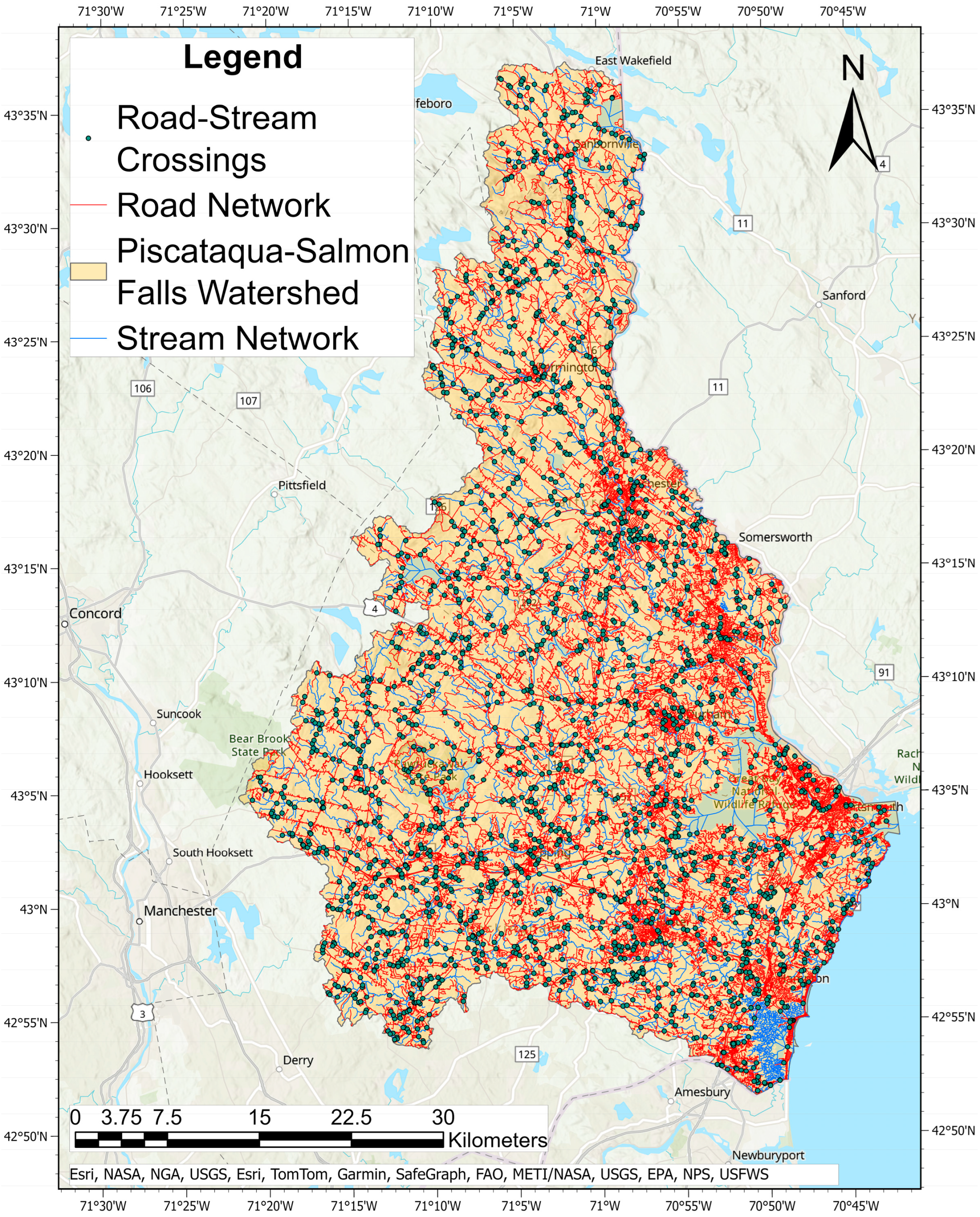
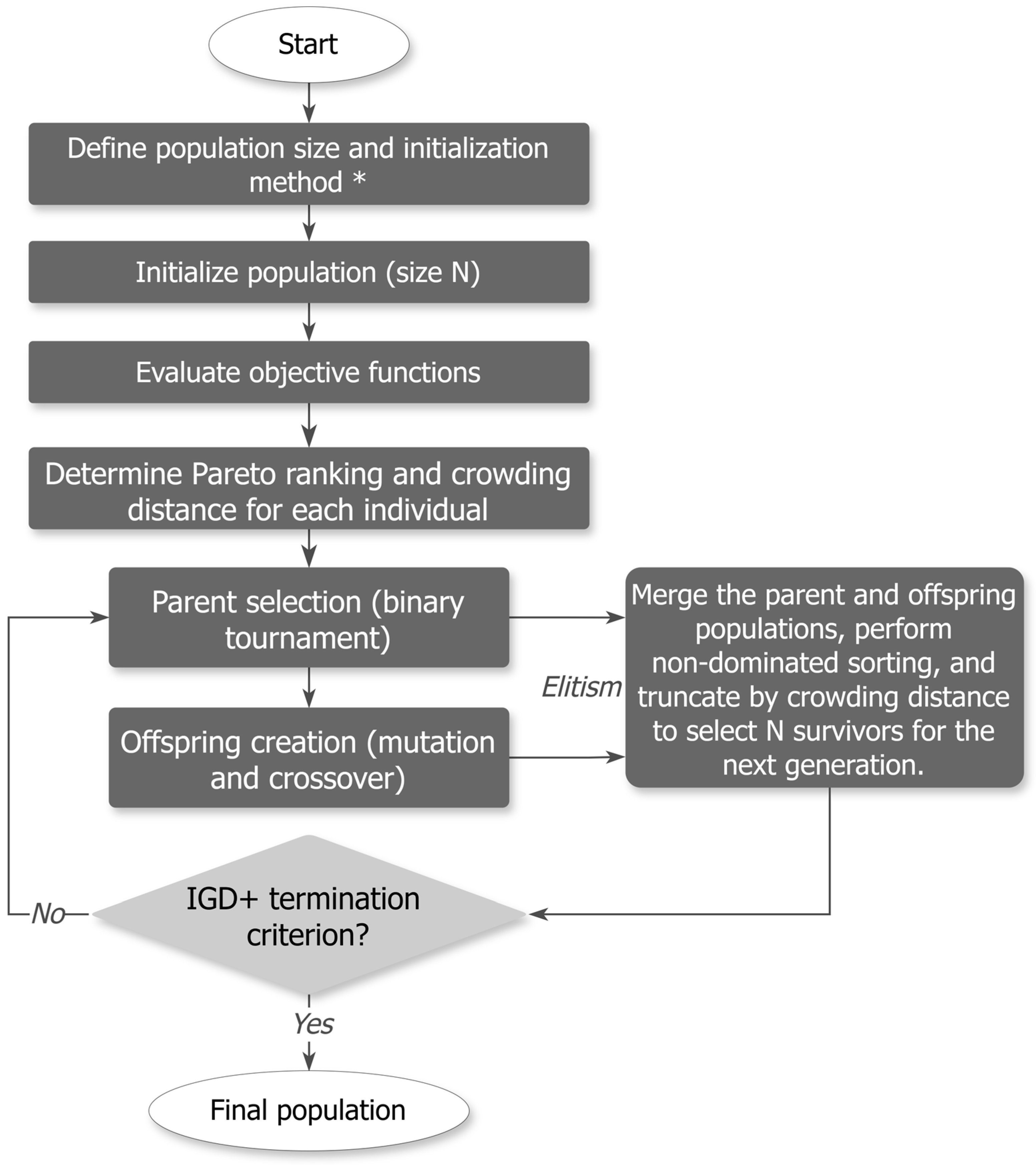
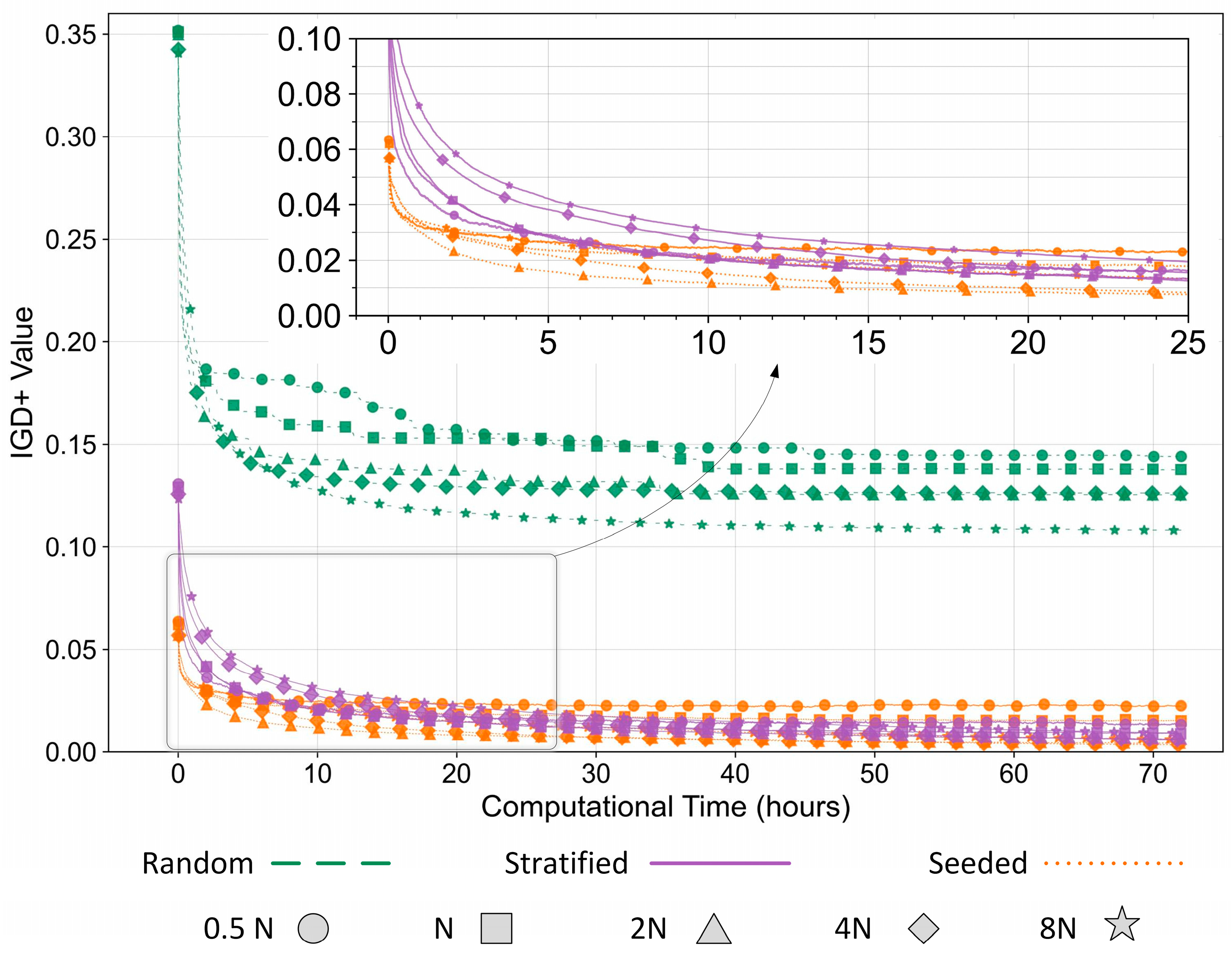

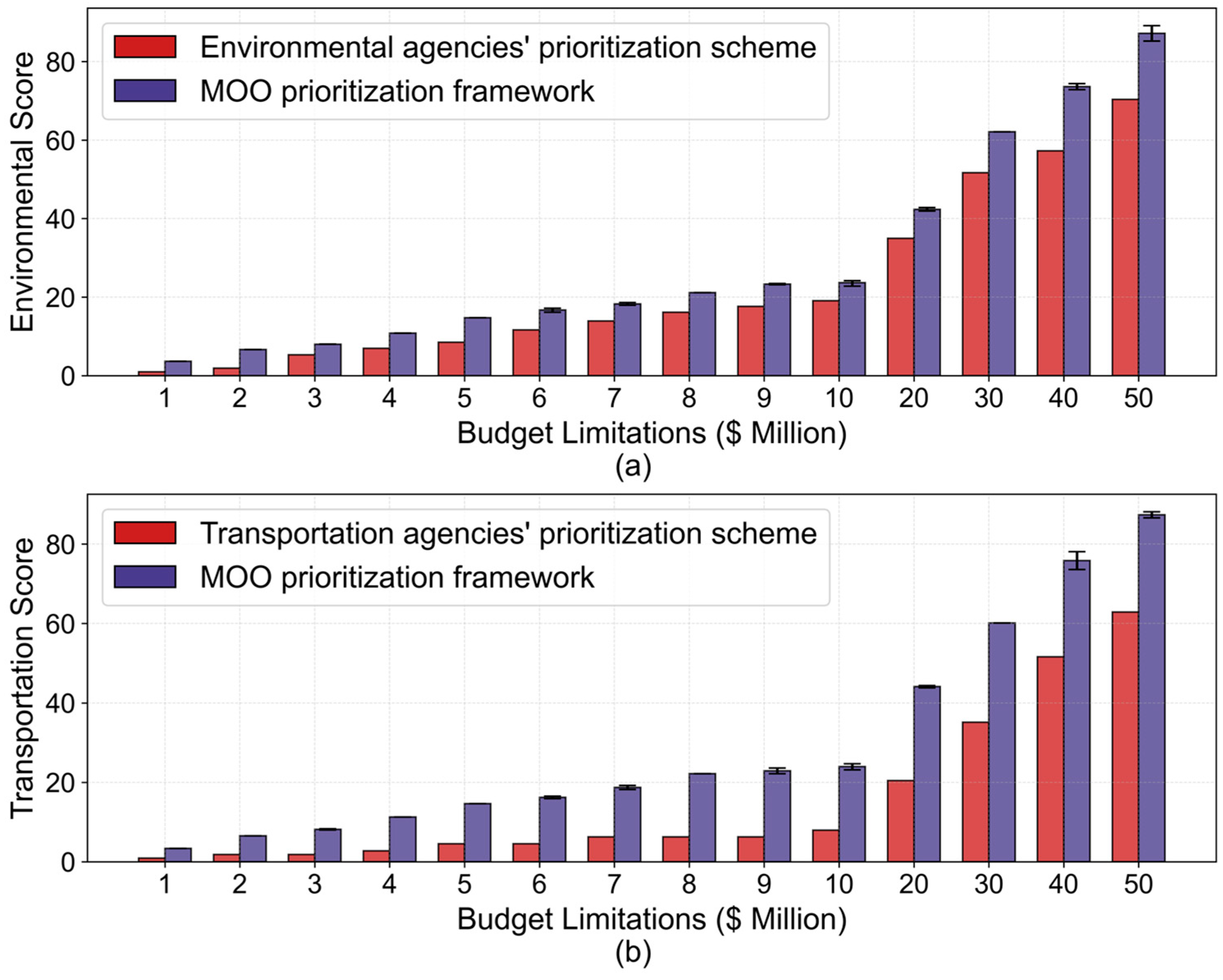
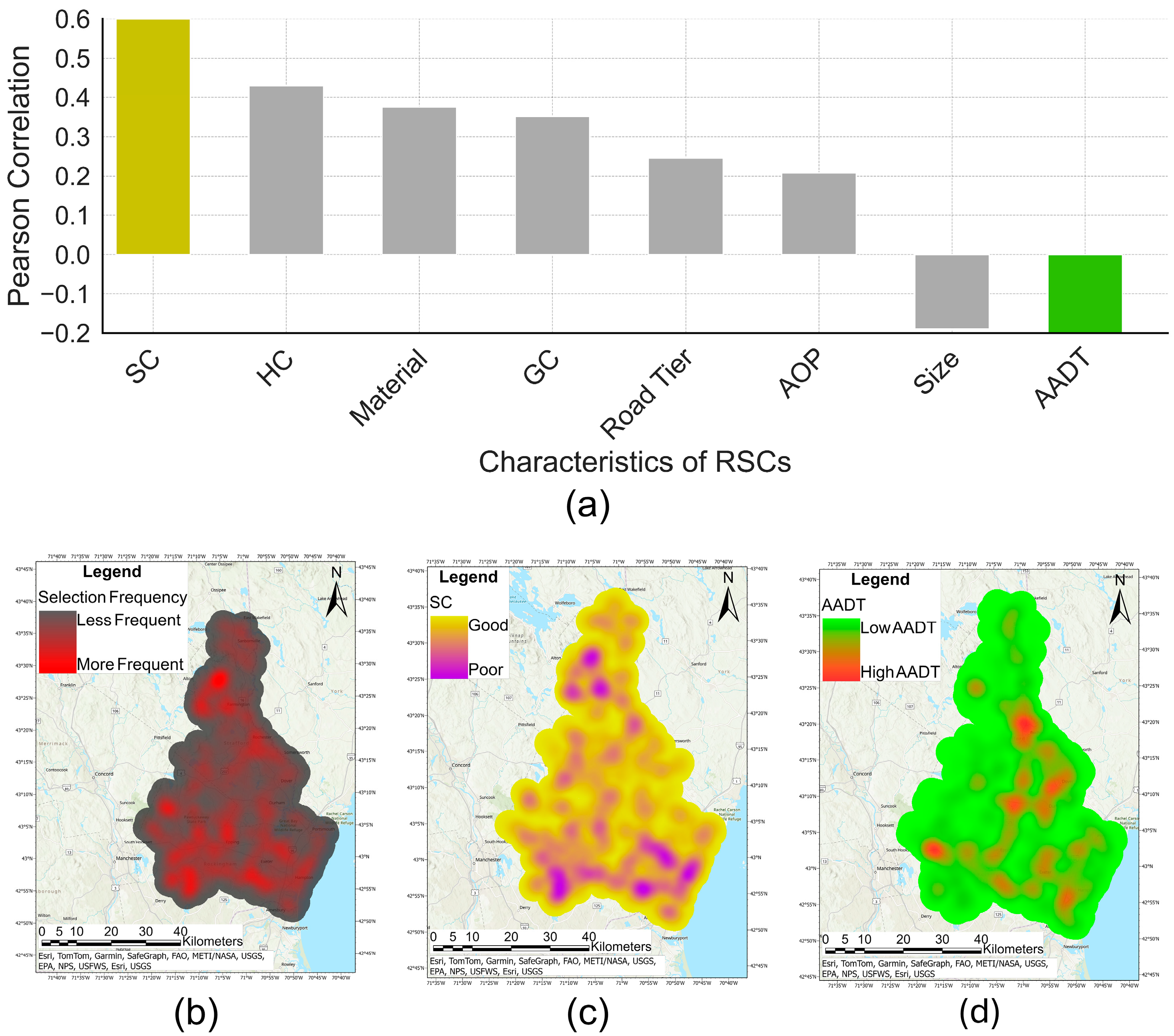
| Criterion | Description | Ratings | Prioritization Scores |
|---|---|---|---|
| Aquatic Organism Passage (AOP) | AOP assesses the capacity of RSCs to facilitate the downstream and upstream migration of aquatic organisms. It is determined by the vertical elevation difference at the outlet (outlet drop), presence and depth of the downstream pool, water depth at the outlet, number of culverts at the crossing, outlet invert type, presence of sediment throughout the structure, partial obstruction, and presence of screening at the inlet and outlet [55]. | Full Passage, No Score—Not Surveyable a | 0 |
| Reduced Passage | 0.33 | ||
| Passage Only for Adult Trout | 0.66 | ||
| No Passage | 1 | ||
| Geomorphic Compatibility (GC) | GC evaluates how well an RSC aligns with the natural geomorphology and hydrological flow of the stream and provides insights into stream and infrastructure health by assessing erosion metrics that affect water quality and width ratios that indicate flood vulnerability [55]. It considers erosion, sediment continuity, structure width ratios, and slope. | Fully Compatible, N/A Score b | 0 |
| Mostly Compatible | 0.25 | ||
| Partially Compatible | 0.5 | ||
| Fully Incompatible | 0.75 | ||
| Mostly Incompatible | 1 | ||
| Hydraulic Capacity (HC) | HC evaluates an RSC’s ability to transport water during storm events using hydraulic equations and streamflow predictions. HC scores have been calculated for flood recurrence intervals of 10, 25, 50, and 100 years based on RSC field surveys. We used the average of HC scores for all four flood recurrence intervals. HC ratings are based on the shape, material, dimensions, slope, and relative elevation of the crossing to the road surface, as well as watershed characteristics such as drainage area, land cover, soil type, and precipitation [56]. | Pass, No Rating—Road Elevation c, No Rating—Wide Span c, No Rating c | 0 |
| Vulnerable | 0.5 | ||
| Overtop | 1 | ||
| Structural Condition (SC) | The SC score assesses the physical state and structural integrity of an RSC. It is based on a visual inspection of the interior walls, surfaces, bottom, wingwalls, and headwalls [57]. | Good | 0 |
| Fair | 0.5 | ||
| Poor | 1 |
| Criterion | Definition | Status | Score |
|---|---|---|---|
| Annual Average Daily Traffic (AADT) | The average number of vehicles passing a specific point on a highway or road per day over a year [59]. | >20,000 | 10.1 |
| 10,000–20,000 | 7.9 | ||
| 6000–10,000 | 5 | ||
| 4000–6000 | 3 | ||
| 2000–4000 | 2 | ||
| <2000 | 1 | ||
| Road Tier | Road tiers are based on the road’s function and significance. Tier 1 consists of Interstates, Turnpikes, and Divided Highways. Tier 2 includes Statewide Corridors. Tier 3 covers Regional Corridors. Tier 4 is made up of Local Connectors. Finally, Tier 5 comprises Local Roads [60]. | Tier 1 | 5 |
| Tier 2 | 4 | ||
| Tier 3 | 3 | ||
| Tier 4 | 2 | ||
| Tier 5 | 1 | ||
| Material | The material used in RSC construction. It can include concrete, metal, plastic, etc. | Metal | 11.3 |
| Masonry | 6 | ||
| Concrete | 1 | ||
| Plastic | 0.5 | ||
| Other | 5 | ||
| N/A | 4 | ||
| Size | Refers to the span (width) of the RSC, measured at the inlet opening. | >60″ | 24.9 |
| 36″–54″ | 16.6 | ||
| 24″–30″ | 10.3 | ||
| <24″ | 0 | ||
| Structural Condition | The physical state and structural integrity of an RSC. | Poor | 40 |
| Fair | 4 | ||
| Good | 0 | ||
| No rating | 2 |
Disclaimer/Publisher’s Note: The statements, opinions and data contained in all publications are solely those of the individual author(s) and contributor(s) and not of MDPI and/or the editor(s). MDPI and/or the editor(s) disclaim responsibility for any injury to people or property resulting from any ideas, methods, instructions or products referred to in the content. |
© 2025 by the authors. Licensee MDPI, Basel, Switzerland. This article is an open access article distributed under the terms and conditions of the Creative Commons Attribution (CC BY) license (https://creativecommons.org/licenses/by/4.0/).
Share and Cite
Asadifakhr, K.; Roy, S.G.; Taherkhani, A.H.; Han, F.; Bell, E.S.; Mo, W. A Multi-Objective Genetic Algorithm Approach to Sustainable Road–Stream Crossing Management. Sustainability 2025, 17, 3987. https://doi.org/10.3390/su17093987
Asadifakhr K, Roy SG, Taherkhani AH, Han F, Bell ES, Mo W. A Multi-Objective Genetic Algorithm Approach to Sustainable Road–Stream Crossing Management. Sustainability. 2025; 17(9):3987. https://doi.org/10.3390/su17093987
Chicago/Turabian StyleAsadifakhr, Koorosh, Samuel G. Roy, Amir Hosein Taherkhani, Fei Han, Erin S. Bell, and Weiwei Mo. 2025. "A Multi-Objective Genetic Algorithm Approach to Sustainable Road–Stream Crossing Management" Sustainability 17, no. 9: 3987. https://doi.org/10.3390/su17093987
APA StyleAsadifakhr, K., Roy, S. G., Taherkhani, A. H., Han, F., Bell, E. S., & Mo, W. (2025). A Multi-Objective Genetic Algorithm Approach to Sustainable Road–Stream Crossing Management. Sustainability, 17(9), 3987. https://doi.org/10.3390/su17093987









